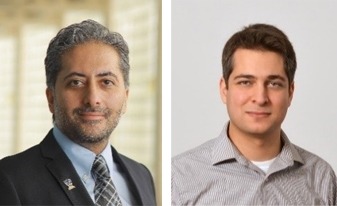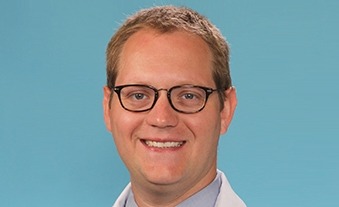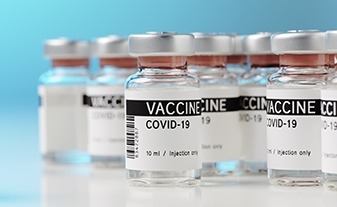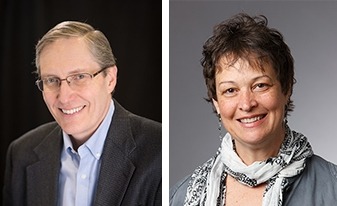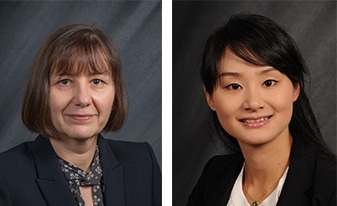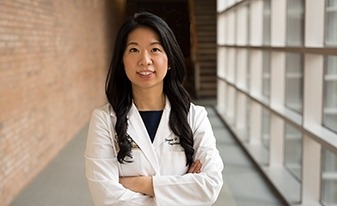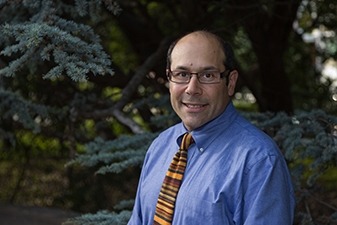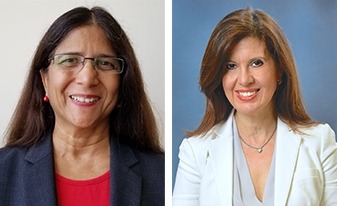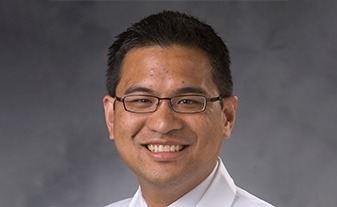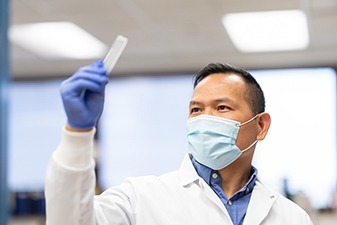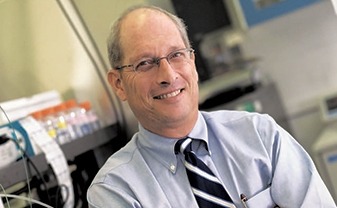Rapid Funding for COVID-19 Research
This page lists the 20 initial COVID-19 research projects that NIDCR funded nationwide as supplements to existing extramural grants. The projects seek to address critical needs, such as minimizing infection risk in dental environments, improving SARS-CoV-2 detection in saliva, and exploring mechanisms of viral entry into oral epithelial cells. The studies range from clinical to basic research, and many are conducted through the National Dental Practice-Based Research Network (National Dental PBRN).
Particle Topography and Aerosol Size Distribution in Dental Settings in COVID-19 Era
Omid Amili & George Choueiri
University of Toledo
Aerosols generated during dental procedures may expose providers to SARS-CoV-2. To better understand aerosol dynamics in dental care environments, the scientists will develop a droplet- and aerosol-generating respiratory patient simulator equipped with a dental typodont. Dentists on the team will perform common procedures on the simulated patient in different dental office layouts, and aerosol particle concentration, accumulation, and dissipation over time will be characterized. The scientists will then use the system to measure the effectiveness of aerosol-reducing approaches during dental care. The findings could inform new strategies to mitigate aerosol spread in dental environments. Learn more on the National Dental PBRN website
Quantifying and Reducing Aerosol Generation in Dental Settings
Michael Joseph Durkin
Washington University
Dental procedures expose clinicians to oral secretions that can become aerosolized and may carry SARS-CoV-2, increasing the risk of transmission to dental healthcare professionals. The researchers will place sensors in clinics and on clinicians to measure aerosol particle size, quantity, and in-air duration during dentistry procedures in various clinical settings with different physical layouts. The “real world” data can help researchers identify aerosol-generating procedures and gauge the extent of aerosol particle spread throughout clinical practice spaces. The findings could inform strategies for reducing aerosol spread during clinical care. Learn more on the National Dental PBRN website
Evaluation of Aerosol Composition in Dental Settings
Michael Joseph Durkin
Washington University
Building on preliminary studies of aerosol generation during routine dental procedures, this project will examine the bacterial and viral as well as the inorganic content of dental aerosols. Researchers will also explore the dilutional effects of water-cooled equipment on dental aerosols. The findings from this study may aid assessing the risk of aerosol transmission of SARS-CoV-2 and other pathogens in dental settings. Learn more on the National Dental PBRN website
Pragmatic Return to Effective Dental Infection Control through Triage and Testing (PREDICT)
Cecile Feldman
Rutgers University
Amid the COVID-19 pandemic, dental offices have employed risk mitigation protocols, but their usefulness is not fully known. To address the issue, the scientists will develop and test the feasibility of several risk-mitigation strategies, including the use of point-of-care testing for SARS-CoV-2 infection. The results are aimed at increasing the safety and confidence of dental providers and their patients during care delivery. Learn more on the National Dental PBRN website
National Dental PBRN COVID-19 Research (CORE) Registry
Jeffrey L. Fellows
Kaiser Foundation Hospitals
Dental procedures generate aerosols that can increase the risk of SARS-CoV-2 transmission in the clinic. The researchers will create a National Dental PBRN registry, called the COVID-19 REsearch Registry (CORE), to capture standardized data from approximately 2,000 practitioners about the approaches they use to reduce transmission risks and associated costs, and their comfort with these methods. The researchers will use a learning health system to present survey results to participating practitioners, followed by a reassessment to evaluate changes in mitigation approaches and comfort levels. The CORE Registry will establish an infrastructure to support the design and conduct of future clinical and implementation studies. Learn more on the National Dental PBRN website
Coronavirus Vaccine Acceptance and Readiness Among Dentists (CARAD)
Jeffrey L. Fellows
Kaiser Foundation Hospitals
This study will evaluate factors that affect dentists’ interest in and ability to provide SARS-CoV-2 vaccines to patients during routine dental office visits. Researchers will conduct qualitative interviews with National Dental PBRN practitioners to identify key barriers and facilitators to vaccine delivery, including vaccine hesitancy, followed by a network-wide survey about 200 practitioners. The findings may point to a role for dentists in helping to mitigate the spread of COVID-19. Learn more on the National Dental PBRN website
Resources and Support for National Dental PBRN COVID-19 Research
Gregg H. Gilbert
National Dental PBRN Administrative and Resource Center
University of Alabama at Birmingham
Mary Ann McBurnie
National Dental PBRN Network Coordinating Center
Kaiser Foundation Research Institute
Two hubs make up the central infrastructure of the National Dental PBRN: the Network Coordinating Center, which oversees data coordination, collection, management, and storage; and the Administrative and Resource Center, which provides resources such as practitioner recruitment and engagement, research-conduct training, communications and dissemination, and management of the network’s single institutional review board. The two centers will jointly provide budgetary support and access to their respective resources for studies conducted through the National Dental PBRN that aim to better understand COVID-19’s impact in dental settings and how to best mitigate its risks to patients and providers. Learn more about the Administrative and Resource Center and the Network Coordinating Center on NIH RePORTER.
Assess an Innovative mDentistry eHygiene Strategy Amid the COVID-19 Pandemic
Dorota Kopycka-Kedzierawski & Jin Xiao
University of Rochester
Amid the COVID-19 pandemic, dental healthcare professionals face the challenges of conserving resources and preventing cross-contamination. To see if virtual dental exams might help to address these concerns, scientists will collect data from 48 dental healthcare practitioners and 192 patients who will undergo an in-office visit with a hygienist and a virtual visit with a dentist. The researchers will assess the level of acceptance, barriers, and economic concerns of patients and practitioners, along with patients’ abilities to take intraoral photos using a digital mobile health tool. The findings could inform models for delivery of virtual oral exams that improve dental care access during public health emergencies and in general. Learn more on the National Dental PBRN website
Evaluating and Improving Personal Protective Equipment Use in Dental Settings
Jennie H. Kwon
Washington University
To protect themselves and patients during the pandemic, dental healthcare providers wear a range of personal protective equipment (PPE), including N95 masks, face shields, eye protection, and surgical gowns. Proper methods for taking PPE on and off—termed donning and doffing—help clinicians avoid contaminating themselves and the dental care environment. The researchers will assess dental clinicians’ current PPE use and then will observe and document protocol deviations and potential self-contamination (via fluorescent markers) as clinicians don and doff PPE. The findings will inform development of an educational video to train dental healthcare professionals to safely don and doff PPE. Learn more on the National Dental PBRN website
SARS-CoV-2 and the Oral Microbiome
Robert A. Burne
University of Florida
Certain oral bacteria are thought to produce compounds that can curb infectivity of pathogens—a mechanism that may help combat SARS-CoV-2. Researchers will screen a large panel of Streptococcus—one of the most abundant types of bacteria in the oral cavity—to find strains that can impede SARS-CoV-2 binding to host cells. Identifying the bacterial genes and compounds responsible for this interference could lead to new interventions that diminish transmission and disease severity. Learn more on NIH RePORTER
Handheld Electrical Sensor for Rapid, Sensitive Detection and Quantification of SARS-CoV-2 from Saliva
Josephine F. Esquivel-Upshaw
University of Florida
Diagnostic testing for SARS-CoV-2 typically involves uncomfortable nasopharyngeal swabs and the use of polymerase chain reaction (PCR) to detect viral RNA, a process that takes several hours and requires specialized lab equipment. To find a faster and less invasive testing method, the researchers developed a sensor that instead detects viral surface proteins (antigens). The sensor could detect SARS-CoV-2 at low concentrations in saliva in less than 30 seconds. Now, the scientists seek to optimize the sensitivity and specificity of the sensor and develop a miniaturized, handheld version that can be used in clinical and everyday settings. Learn more on NIH RePORTER
Coordinating Center to Help Eliminate/Reduce Oral Health Inequalities in Children
Stuart A. Gansky
University of California, San Francisco
To help prevent COVID-19 transmission, experts have recommended that patients rinse with an antiseptic mouthwash before undergoing dental procedures. However, the effectiveness of this approach has not been scientifically evaluated. This NIDCR-supported coordinating center will provide administrative support for a University of California-funded pilot clinical trial to assess the effect of mouthwashes on viral load in COVID-19-infected adults. The findings could shed light on clinical care methods that better protect dental clinicians and patients from the virus. Learn more on NIH RePORTER
Economic Evaluation of School-based Caries Programs
Shulamite S. Huang
New York University
Many people have delayed dental care or faced challenges accessing oral care during the pandemic. To determine if such reduced care has affected vulnerable children, this project will examine how trends in dental-related care changed before and during the pandemic among children enrolled in Medicaid in New York. The study will also assess the impact that pre-pandemic school-based cavity-prevention programs have had on dental-related health visits. Learn more on NIH RePORTER
Mouthwash Use, Oral Nitric Oxide Metabolism and COVID-19
Kaumudi J. Joshipura & Evangelia Morou
University of Puerto Rico
Recent research indicates that certain types of antiseptic mouthwash can kill SARS-CoV-2 viruses, raising the possibility that mouthwash use could decrease oral viral load in infected people and potentially reduce the risk of transmission to others. However, by disrupting the oral microbial balance, regular use of mouthwash may also interfere with the production of nitric oxide, a key molecule that helps regulate inflammation and endothelial function and that has demonstrated antiviral properties against SARS-CoV-2. The researchers will evaluate the associations between mouthwash use, nitric oxide metabolism in the mouth, and COVID-19 outcomes in patients. The results could provide insight into the potential role of mouthwash in the diagnosis, prognosis, and outcomes of COVID-19 in patients. Learn more on NIH RePORTER
COVID-19 PPE for Low- and Middle-Income Countries
Walter T. Lee
Duke University
This project builds on an ongoing NIDCR-supported effort to create a low-cost flexible device (a type of nasolaryngoscope) to help health providers in low-resource settings visualize a patient’s throat and nasal cavity for early screening of cancerous lesions. With this supplemental support, researchers will develop an innovative sheath to be used with the prototype nasolaryngoscope during exams to reduce the risk of viral transmission to health care providers and improve patient comfort. Learn more on NIH RePORTER
Community Intervention Modifications for Low-Income Urban Families after COVID-19
Molly A. Martin
University of Illinois at Chicago
In a study funded by NIDCR prior to the COVID-19 pandemic, the researchers have been developing and testing interventions to reduce oral health disparities in low-income urban families. Now, the team seeks to understand how the pandemic has affected access to dental healthcare and social services among the 420 young children and their families currently enrolled in the study. The scientists will identify intervention needs in dental care access, oral health behaviors, nutrition, and mental health to help families establish healthy oral care habits that can outlive the pandemic. Learn more on NIH RePORTER
Identification of Genetic Risk and Protective Factors Associated with COVID-19
Cuong Q. Nguyen
University of Florida
COVID-19 symptoms can range from mild to severe. Some scientists think genetic variation in human leukocyte antigens (HLAs)—a set of immune-stimulating proteins on the surfaces of host cells—could underlie differences in disease severity. To explore this possibility, researchers will genotype asymptomatic and symptomatic COVID-19 patients to understand how HLA genetic variations correlate with symptom severity. These variations could serve as genetic biomarkers for predicting COVID-19 severity, making it possible to identify and potentially protect susceptible individuals, including dental providers, healthcare professionals, and other front-line personnel working in high-risk environments. Learn more on NIH RePORTER
Impact of COVID-19-Related Dental Care Modifications in Cancer Patients
Mukund Seshadri
Health Research Inc. & Roswell Park Cancer Institute
The pandemic has led to changes in the delivery of dental and oral healthcare. However, the impact of these changes, especially in high-risk populations such as cancer patients, is unknown. Using electronic health records and patient surveys, the researchers will assess how delays in care have affected high-risk cancer patients and survivors, including oral health complications related to cancer treatment. The group will also develop strategies to triage and manage the oral health of cancer patients through a combination of screening, SARS-CoV-2 testing, and teledentistry. Learn more on NIH RePORTER
Identification of Novel Host Proteins Involved in SARS-CoV-2 Trafficking
Bruce J. Shenker
University of Pennsylvania
One promising approach to combatting SARS-CoV-2 is to block the virus from entering host cells. To better understand how the virus gains entry, the scientists will examine a host cell protein called cellugyrin, which they propose plays a role in periodontitis. In earlier NIDCR-funded research, the scientists showed that cellugyrin is critical to the entry and movement of bacterial toxins within cells in the oral cavity, and they suspect that this “gateway” role may extend to viruses. The researchers will test whether cellugyrin is involved in SARS-CoV-2 entry into cells of the mouth and lungs, and if so, if it can be co-opted to prevent the virus’s entry and infection. Learn more on NIH RePORTER
Novel Role for the P2Y2 Receptor in SARS-CoV-2 Infection in the Oral Cavity
Gary Andrew Weisman
University of Missouri
Impeding the entry of SARS-CoV-2 into host oral epithelial cells may be a promising strategy for preventing viral infection. In previous studies, the researchers found that oral cell surface P2Y2 receptors have unique structural features that could play a role in SARS-CoV2 infection through the oral cavity. The researchers will determine whether P2Y2 receptors promote or inhibit SARS-CoV-2 interaction with cellular proteins known to facilitate the virus’s entry into host cells, and whether cells in the oral cavity are significant players in viral infectivity. Learn more on NIH RePORTER
March 2021

